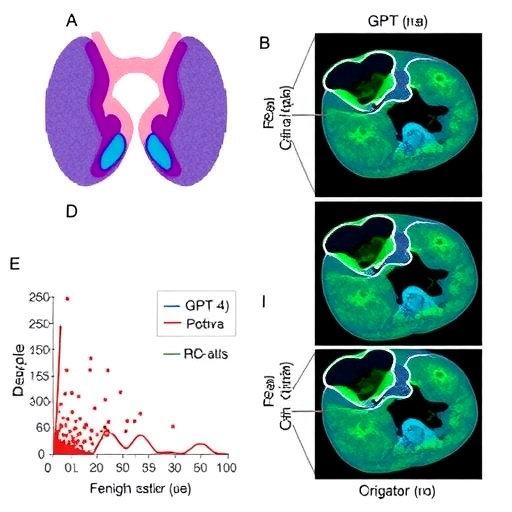
In a groundbreaking advancement that promises to revolutionize the field of additive manufacturing, researchers have unveiled a novel workflow known as GRACEâan acronym for context-aware volumetric printing. This innovative approach leverages the unique capabilities of volumetric printing combined with advanced imaging and computational techniques to produce geometries that dynamically adapt to their surrounding biological or structural environments. By fusing light-sheet microscopy, sophisticated computer vision algorithms, and precision parametric modeling, GRACE navigates multiple scales of complexity, ranging from microscopic organoids to large, macroscopic constructs. This fusion allows rapid fabrication of intricate architectures that respond intelligently to diverse features dispersed throughout the three-dimensional print volume.
The essence of GRACE lies in its ability to automatically detect and interpret spatial features within the printing volume, enabling it to tailor the printing parameters during the fabrication process. Such automated adaptability is an extraordinary leap beyond conventional manual design, which can often be tedious and prohibitively time-consuming. By requiring minimal user inputâlimited primarily to tuning experiment-specific parametric modelsâGRACE streamlines fabrication workflows without compromising the structural complexity or functional specificity of the resultant objects. This automation unlocks new realms of possibilities for creating highly specialized and smart structures with applications spanning tissue engineering, soft robotics, and beyond.
Central to the GRACE framework is the integration of light-sheet microscopy, which facilitates high-speed, volumetric imaging of biological samples or other volumetric data sources. Light-sheet imaging provides detailed, high-resolution insight into the internal architecture of samples several centimeters in size, allowing the workflow to intelligently map the three-dimensional layout of target features. Following acquisition, advanced computer vision algorithms interpret this imaging data, identifying key elements such as cellular clusters, scaffold boundaries, or other spatial heterogeneities. These insights are then fed into parametric modeling algorithms that modulate the printing process, ensuring that the fabricated geometry seamlessly incorporates and responds to these detected features.
Beyond its impressive initial implementation, the GRACE concept holds potential for integration with a diverse set of other cutting-edge fabrication modalities. For example, xolographyâa volumetric printing technology fundamentally based on light-sheet opticsâcould readily incorporate such context-aware workflows. Similarly, multiphoton printing techniques, which exploit nonlinear optical effects to fabricate minute features, as well as acoustic-based and extrusion printing methodologies conducted within supportive suspension baths, can also benefit from this approach. Importantly, the parametric models underpinning GRACE operate independently of the imaging modality employed, offering the flexibility to explore other volumetric scanning technologies. Optical tomography and holographic imaging present promising alternatives that can capture non-fluorescent specimens while potentially minimizing phototoxicity, thereby broadening the versatile application realm of GRACE.
One of the most exciting prospects unlocked by GRACE is its capacity for âoverprintingââthe ability to perform additional, contextually sensitive printing operations on previously fabricated structures. This innovation has immediate relevance in fields such as soft robotics, where it can enable the precise layering of polymeric skins atop movable parts or the controlled formation of hydrogel-based osmotic actuators upon skeletal-like scaffolds. Such fine spatial control enhances the sophistication and functionality of soft robotic components, ultimately providing more lifelike movements and adaptable material properties.
In the realm of biofabrication, GRACE presents unprecedented opportunities for producing biomimetic scaffolds that adapt in real-time to the spatial distribution of living cells or organoids. This level of architectural control is critical for engineering tissue constructs with tailored microenvironments, directly influencing cellular function, differentiation, and tissue maturation. The implications for biomedical research and pharmaceutical testing are profound, as these constructs can serve as advanced in vitro models that more closely replicate native tissue physiology. While current light-sheet imaging technology supports scanning over multicentimeter volumes, ongoing development aims to scale these capabilities to match the dimensions required for full human tissue constructs, potentially through the combination of movable vats and sample mosaicking techniques.
As GRACE is scaled up, new challenges related to light scattering during volumetric imaging and printing are anticipated. The optical properties of large biological tissues can degrade imaging quality and printing precision, necessitating the implementation of advanced light control strategies. Recent progress in controlling light propagation through scattering materials, alongside innovations in holographic tomographic volumetric additive manufacturing, offers promising solutions to overcome these barriers. These advancements will be critical to realizing large-scale, high-resolution, and context-aware volumetric printing applicable to clinical and industrial settings.
Material science is also poised to play an integral role in expanding GRACEâs impact. The convergence of self-assembling materials with this printing workflow could further bridge the gap between hierarchical biological complexity and fabricated constructs. Self-assembly enables microscopic and nanoscale control over cellular microenvironments, providing biochemical and biomechanical cues essential for tissue development. When combined with macro-to-micro scale adaptations achievable via GRACEâs parametric models, the resulting composite materials could closely mimic the multiscale architecture of living tissues, fostering advances in regenerative medicine and bioengineering.
Furthermore, GRACE opens intriguing avenues for post-printing modifications. The capacity to adapt an objectâs structure or properties at any stage following fabrication allows for spatially selective biochemical grafting, modulation of stiffness gradients, or tuning of viscoelastic responses. Such versatility could enable dynamic adjustment of mechanical environments to influence cellular behaviors or enhance the functional lifetime of printed devices. This adaptability represents a transformative shift in additive manufacturing, moving from static, pre-formed constructs to responsive, evolvable systems.
The implications of GRACE extend far beyond biological applications. Its ability to generate complex, context-sensitive geometries with minimal user intervention offers a new paradigm in general additive manufacturing. Complex industrial parts with embedded sensing elements, adaptive surface textures, or multi-material compositions could benefit from such automated workflows. The reduction in manual design burden combined with increased printing sophistication accelerates innovation cycles and potentially reduces costs.
While the current study demonstrates GRACEâs powerful capabilities within well-controlled experimental scenarios, the researchers emphasize that future work is necessary to scale and optimize this technology. Challenges such as expanding imaging volumes, mitigating optical scattering, and integrating alternative imaging modalities remain active areas of development. The synergy between advanced imaging hardware, computational modeling, and novel materials will be pivotal in unlocking the full potential of context-aware volumetric printing.
In conclusion, GRACE heralds an exciting new chapter in the evolution of additive manufacturing. By transcending the limitations of manual design and static printing geometries, it introduces a level of adaptability and intelligence previously unheard of in three-dimensional fabrication. Its interdisciplinary integration of optics, computational science, and materials engineering showcases the promise of convergent technologies to deliver smarter, more functional, and highly customized manufactured objects. As this technology matures, it is poised to transform diverse fields ranging from tissue engineering and soft robotics to industrial manufacturing and beyond, marking a significant leap forward in how we conceive and create three-dimensional structures.
Subject of Research: Adaptive and context-aware volumetric printing combining light-sheet microscopy, computer vision, and parametric modeling for advanced additive manufacturing and biofabrication.
Article Title: Adaptive and context-aware volumetric printing.
Article References:
Florczak, S., GröÃbacher, G., Ribezzi, D. et al. Adaptive and context-aware volumetric printing. Nature 645, 108â114 (2025). https://doi.org/10.1038/s41586-025-09436-7
Image Credits: AI Generated
DOI: https://doi.org/10.1038/s41586-025-09436-7
Keywords: volumetric printing, GRACE, light-sheet microscopy, computer vision, parametric modeling, biofabrication, additive manufacturing, soft robotics, overprinting, biomimetic scaffolds, tissue engineering, adaptive manufacturing
Tags: adaptive volumetric printingautomated fabrication techniquescomputer vision in additive manufacturingcontext-aware manufacturingdynamic geometry adaptationGRACE workflow in 3D printingintelligent material structureslight-sheet microscopy applicationsprecision parametric modeling in printingsoft robotics innovationsspatial feature detection in printingtissue engineering advancements




